
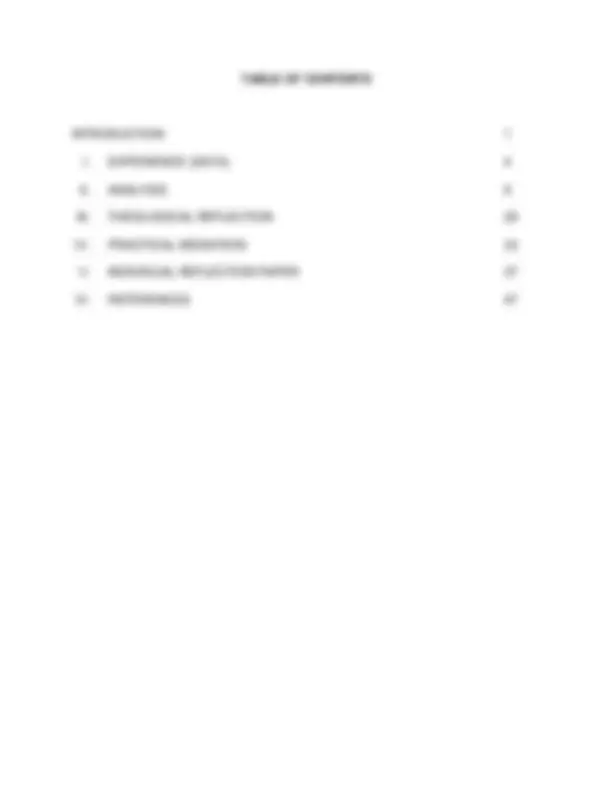

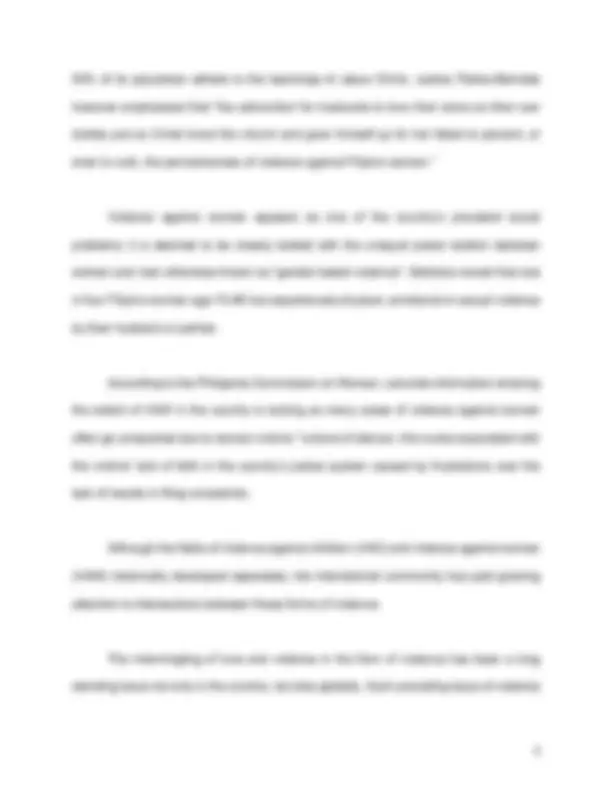
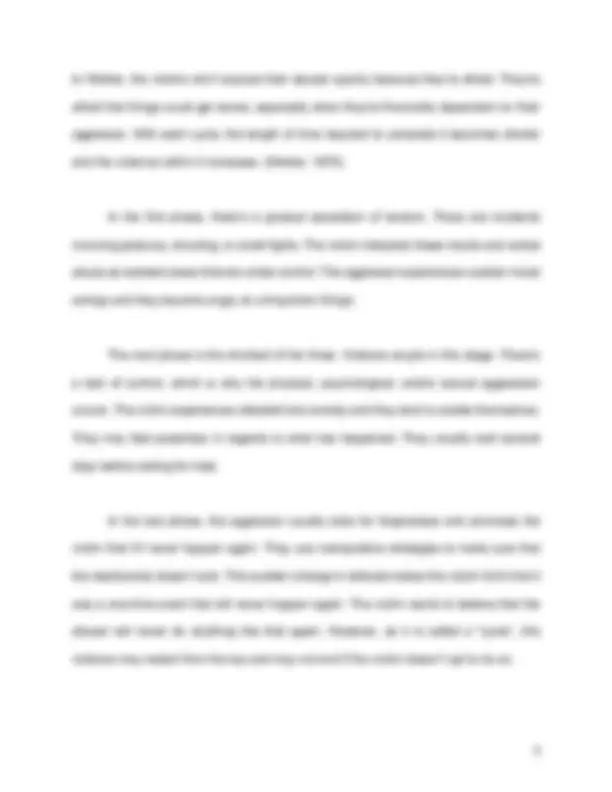
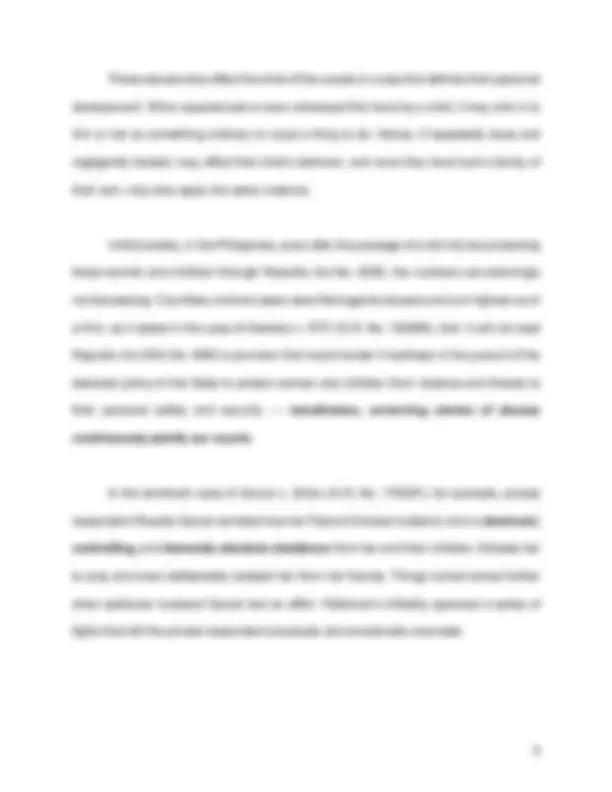
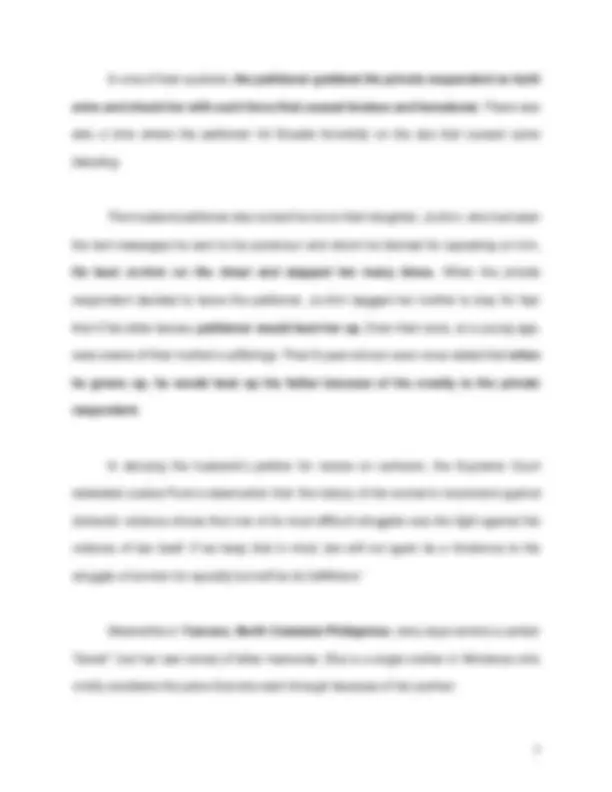
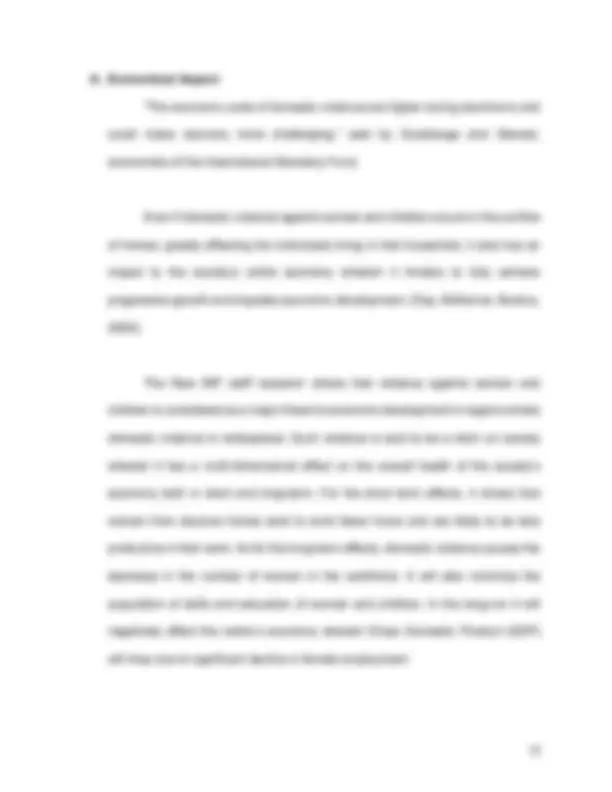
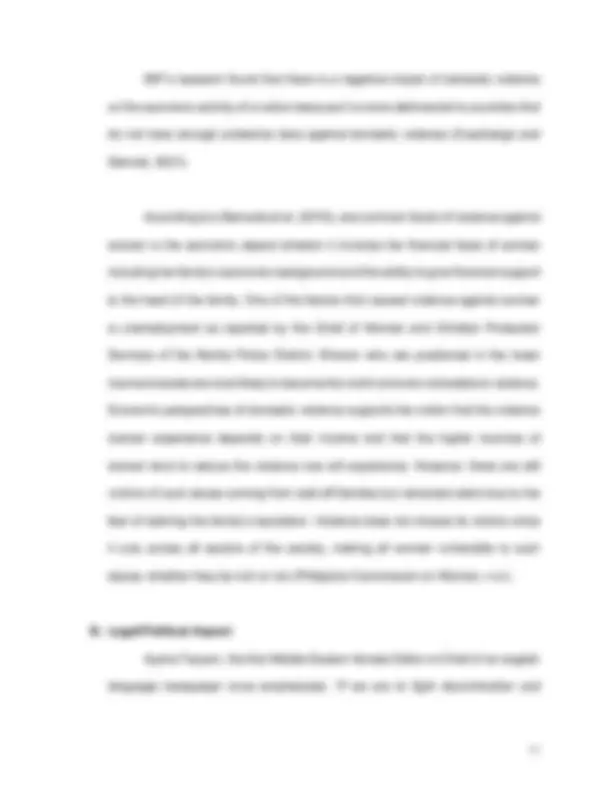
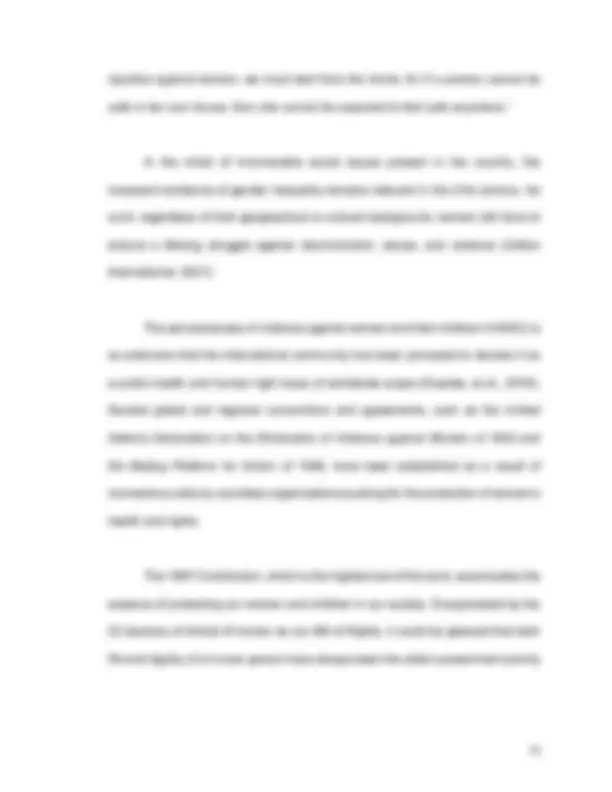
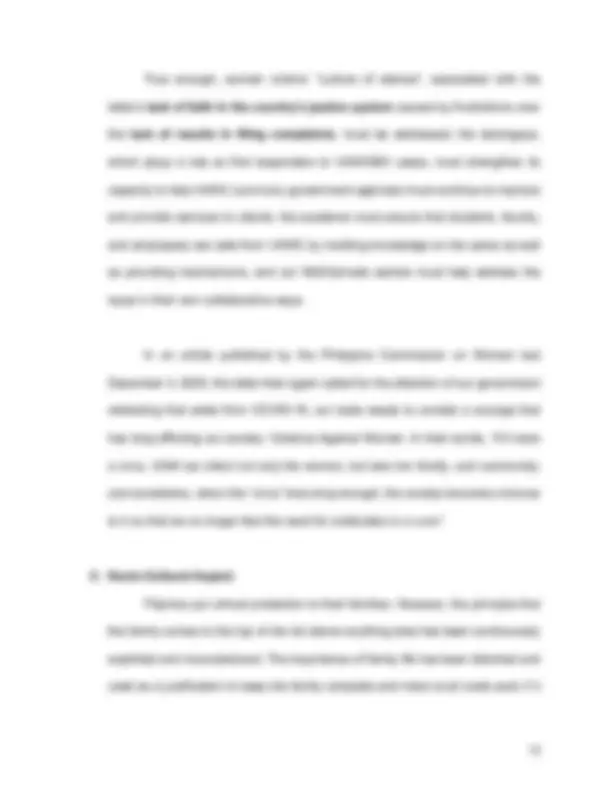
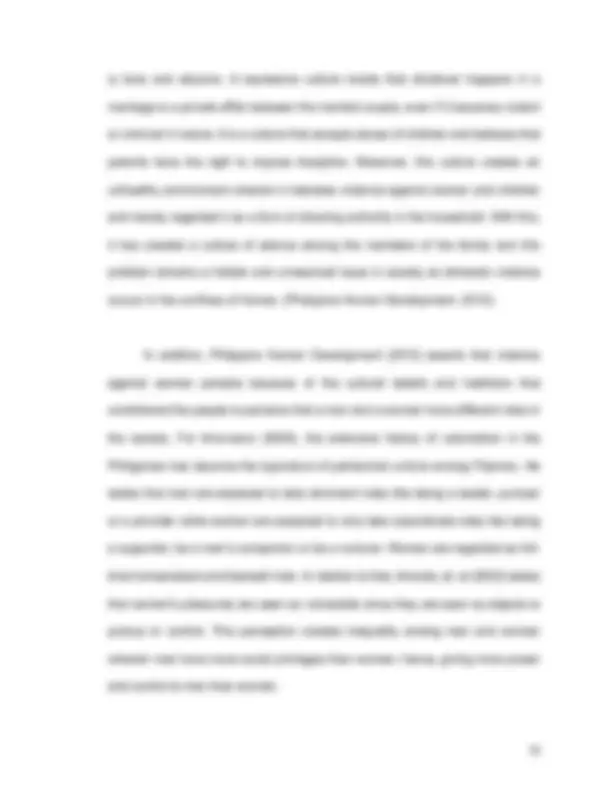
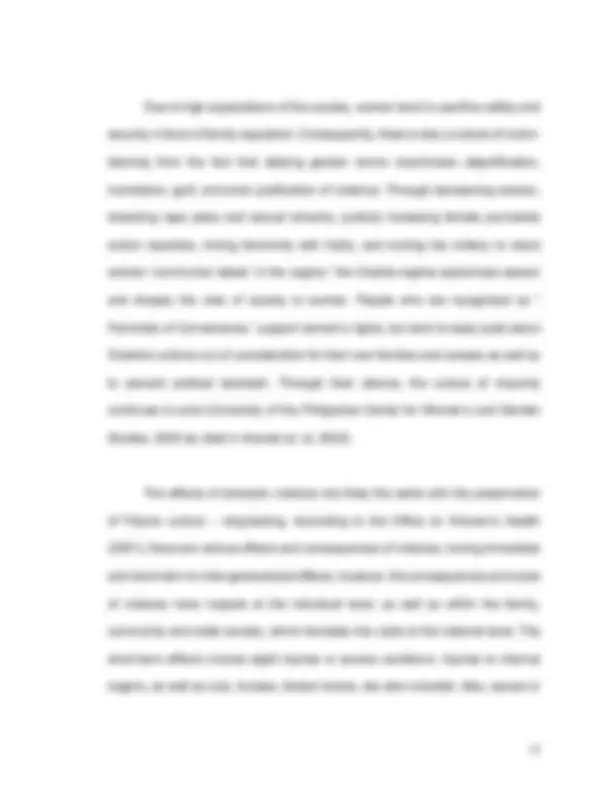
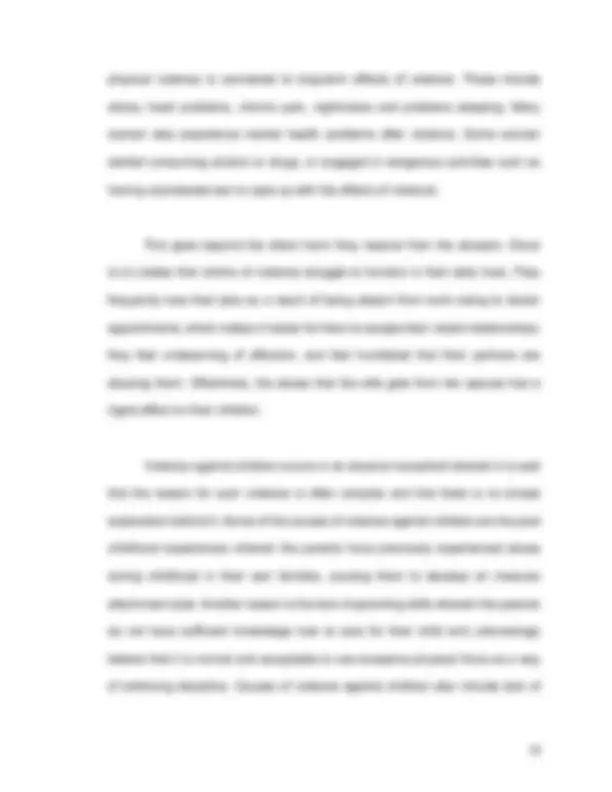
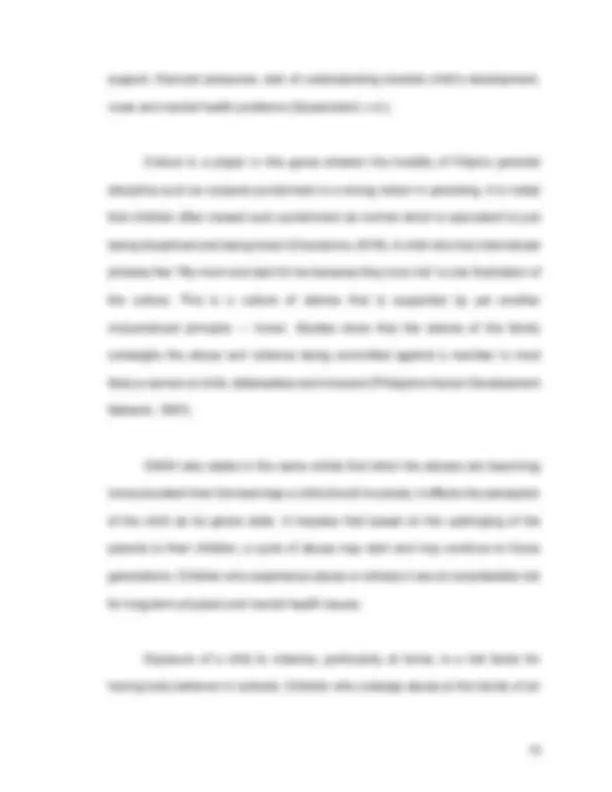
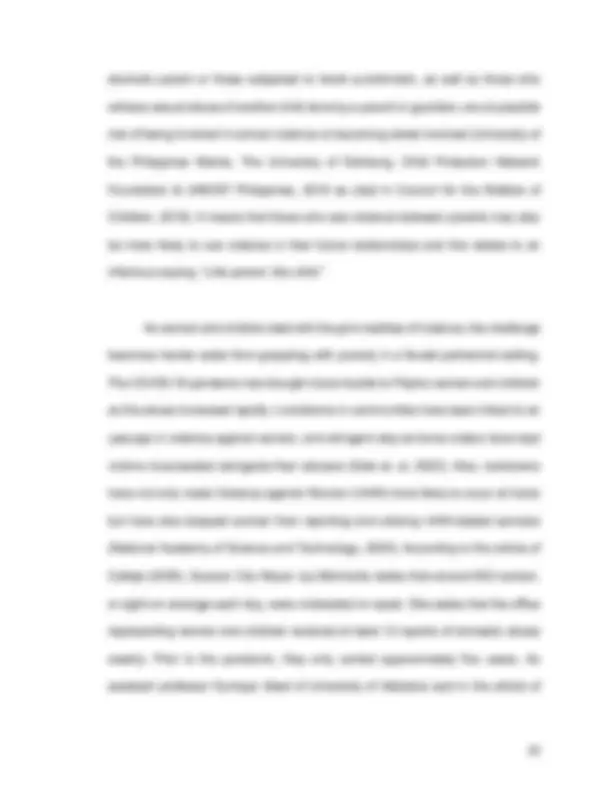
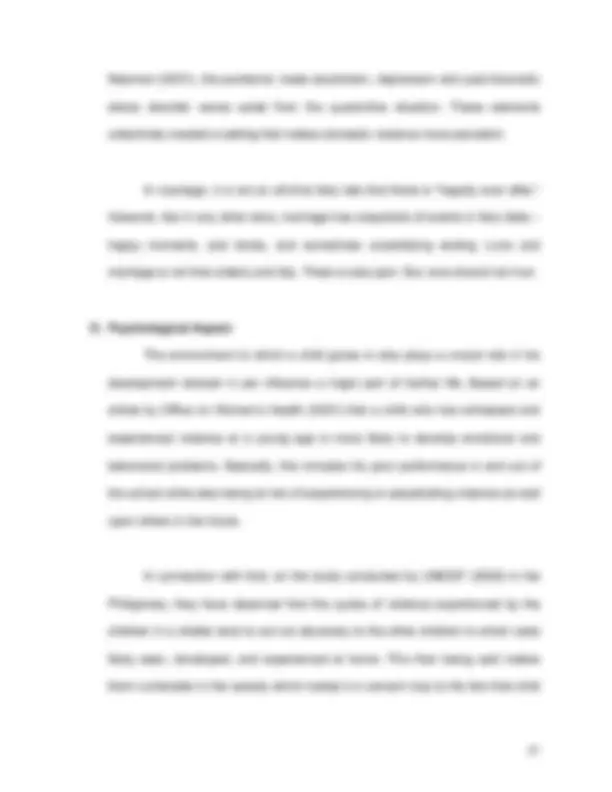
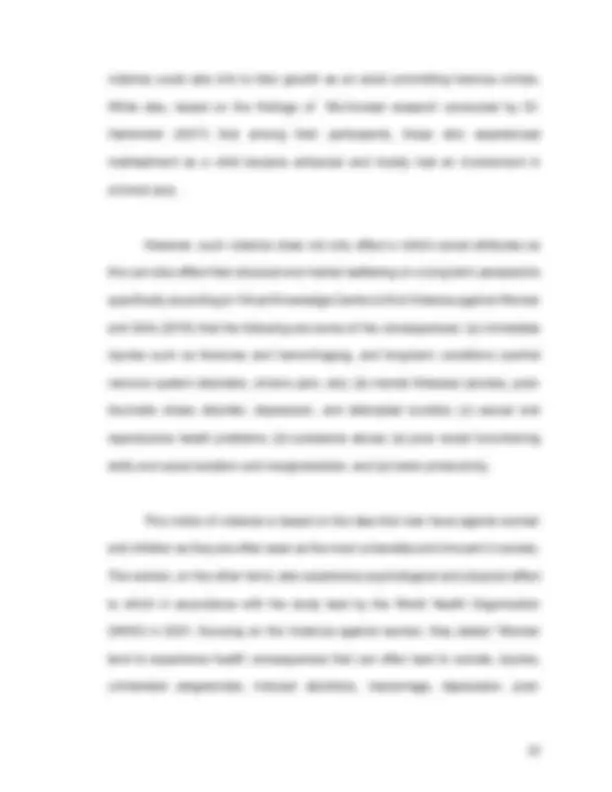
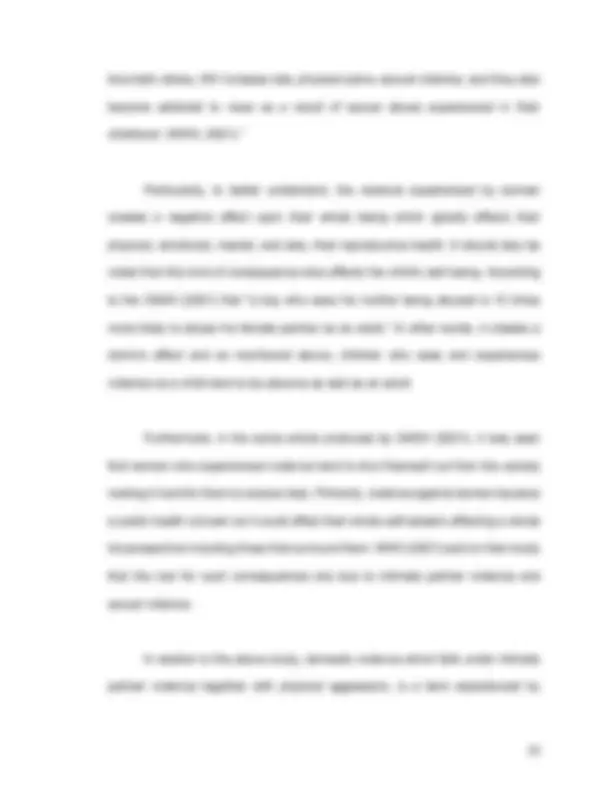

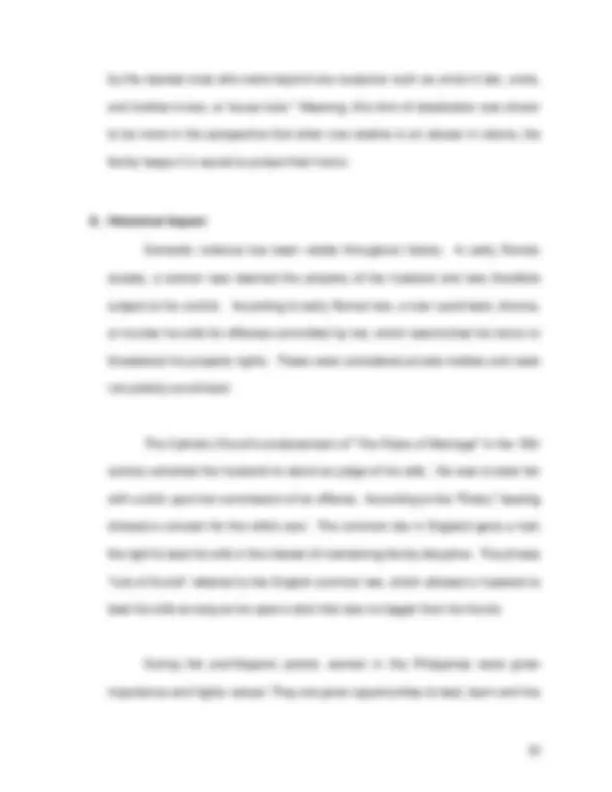
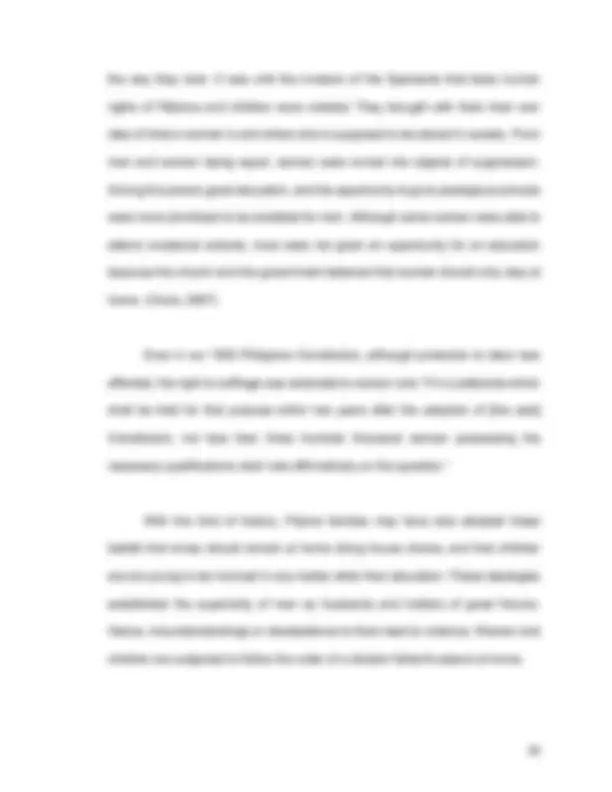
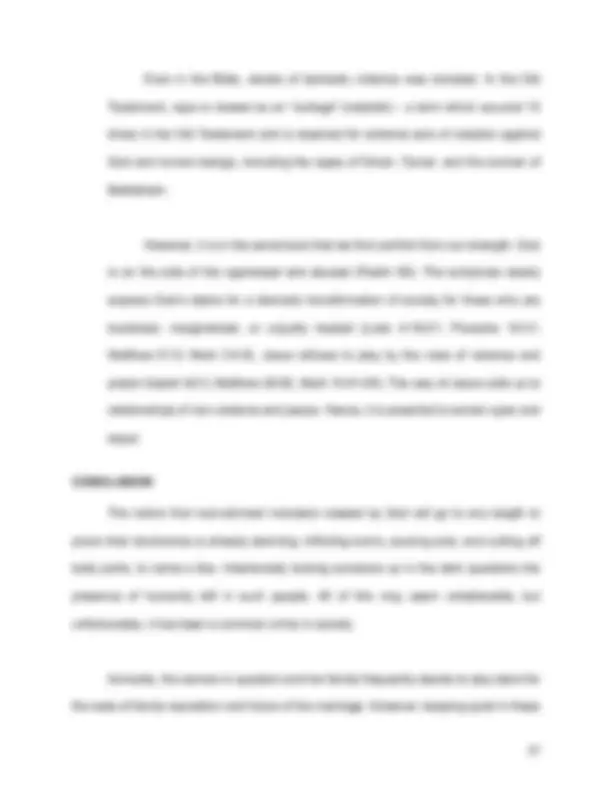

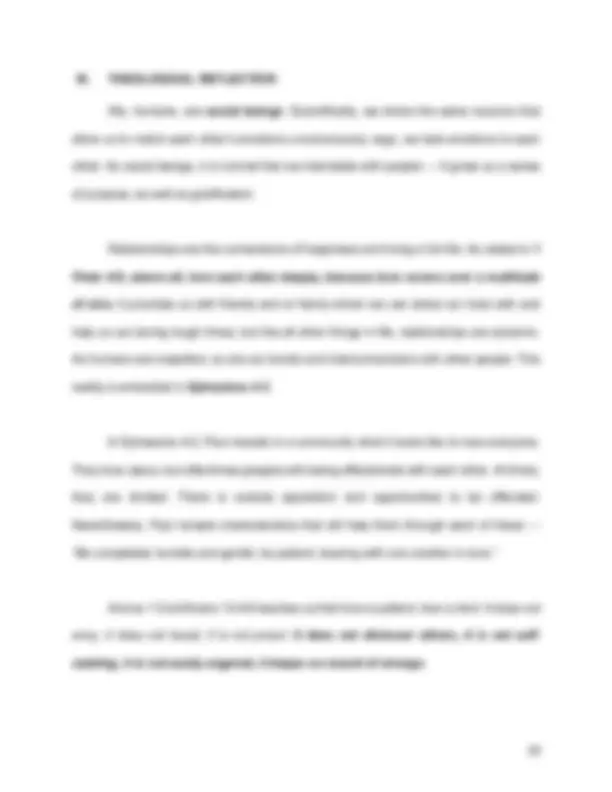
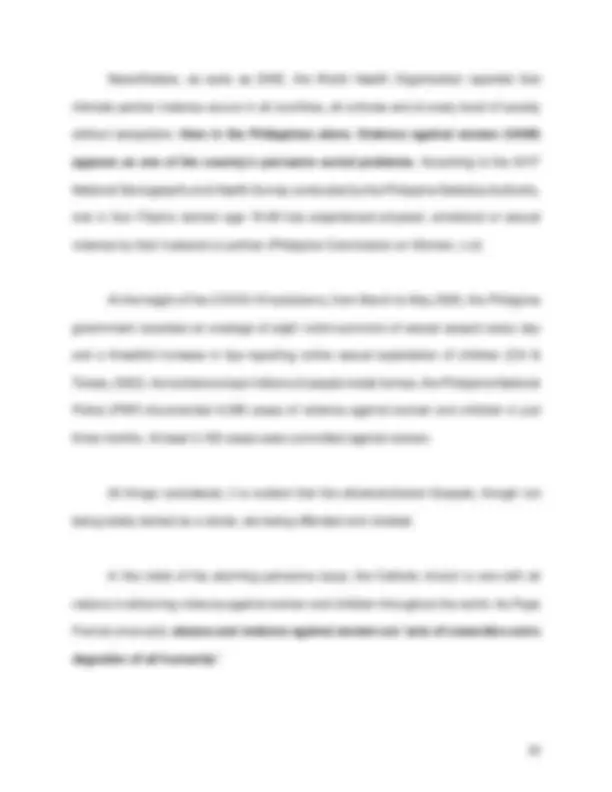
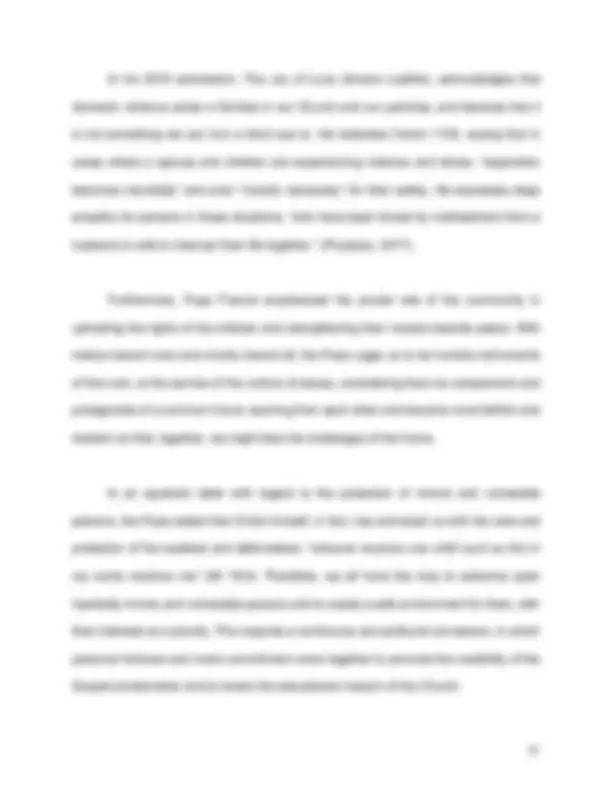
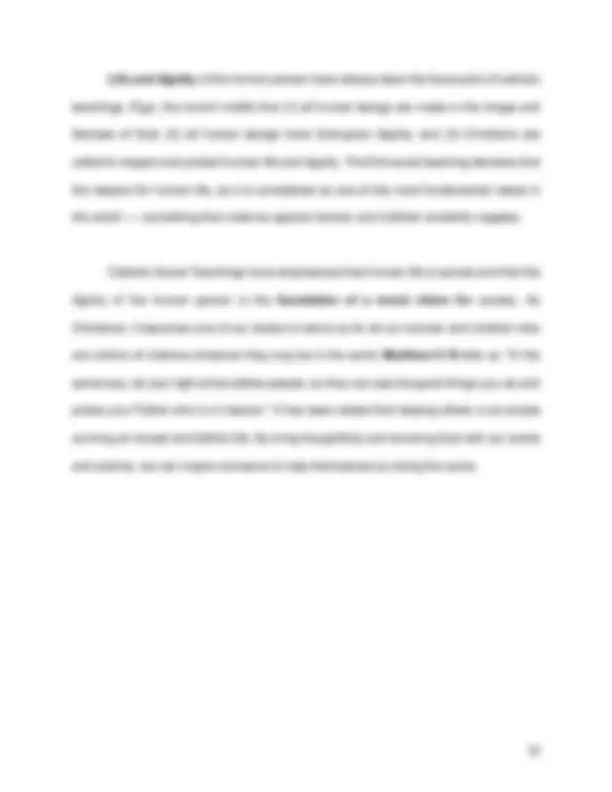
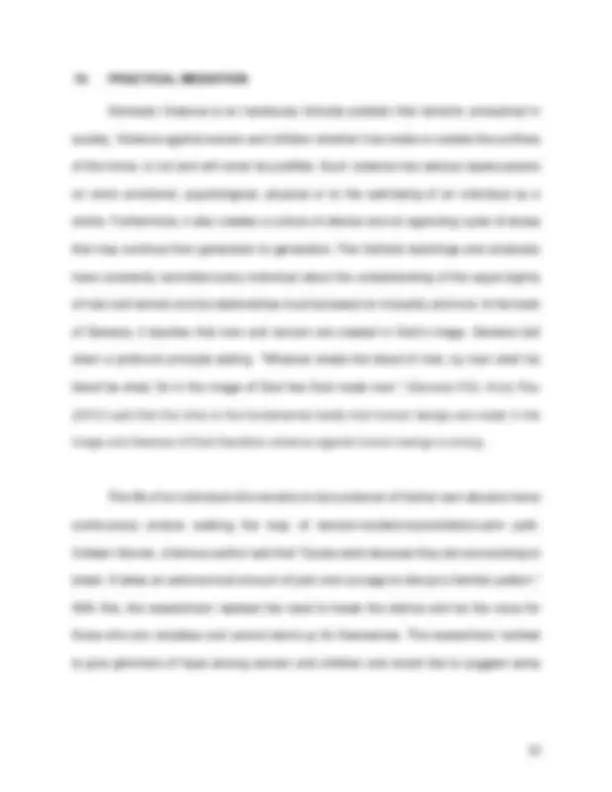
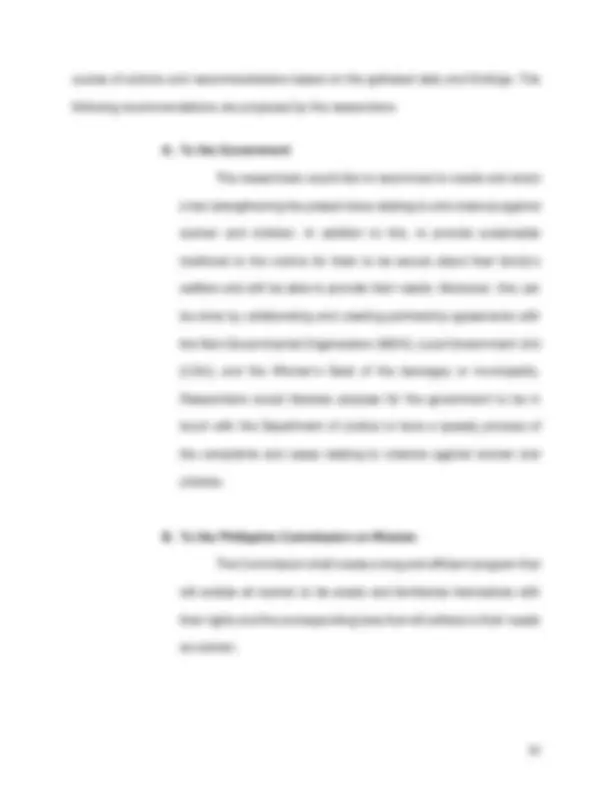
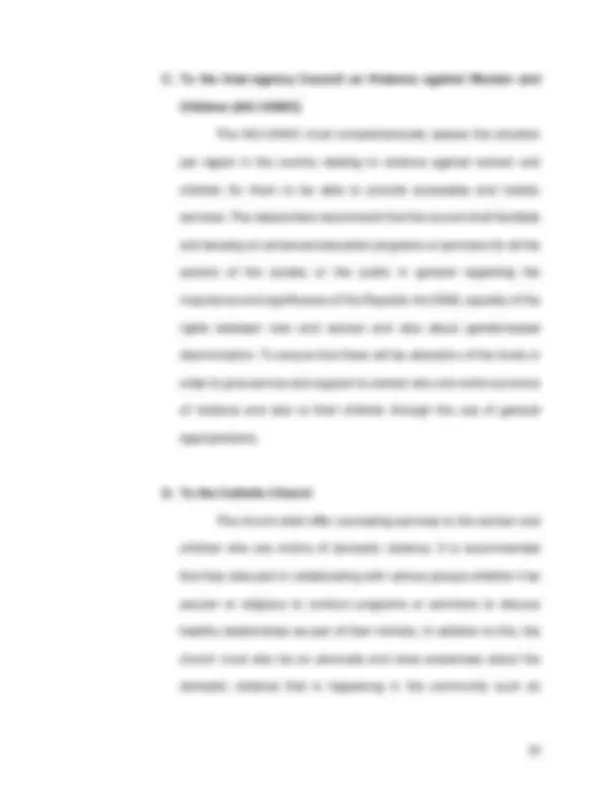
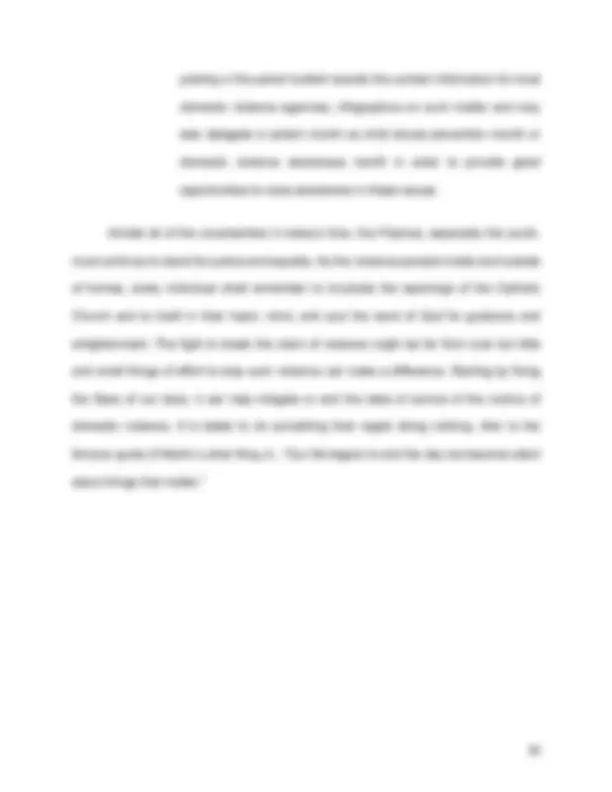
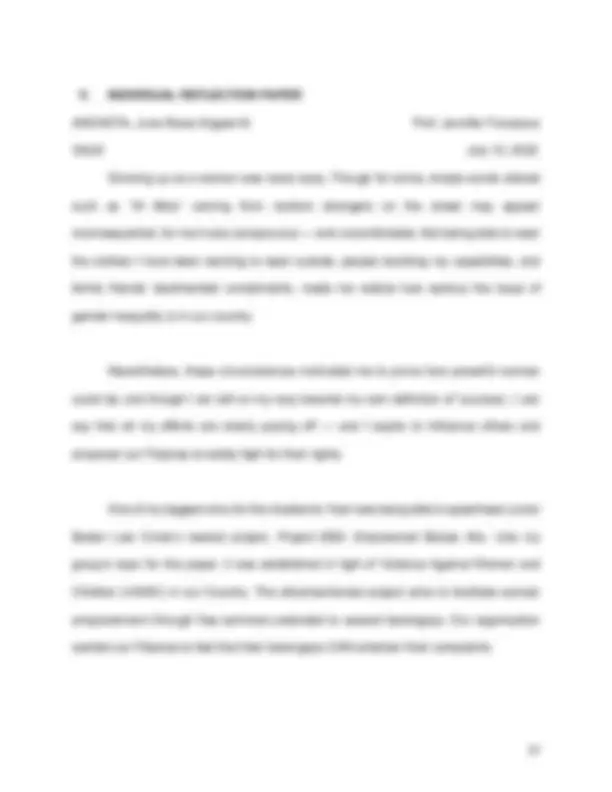
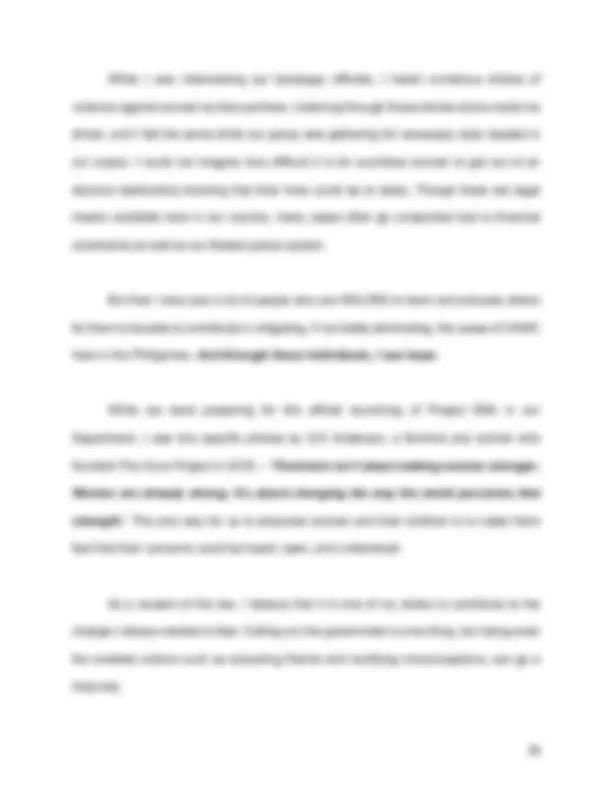
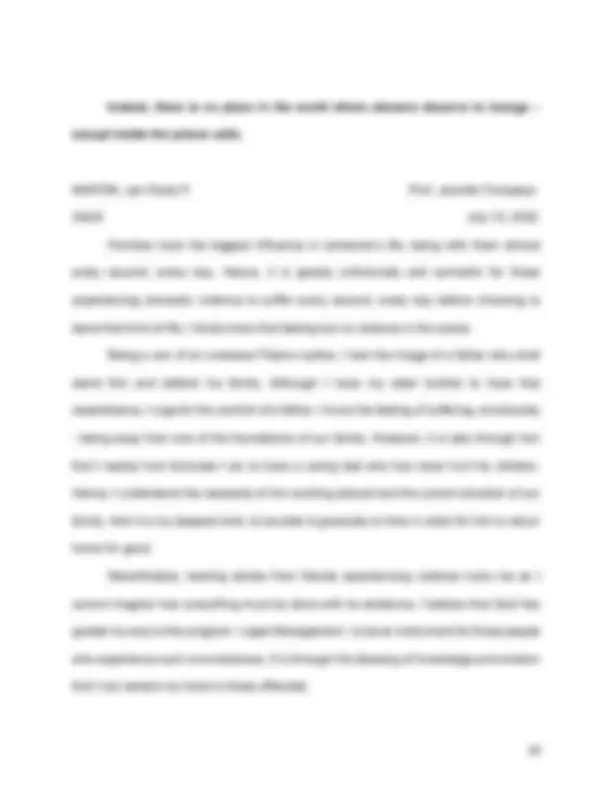
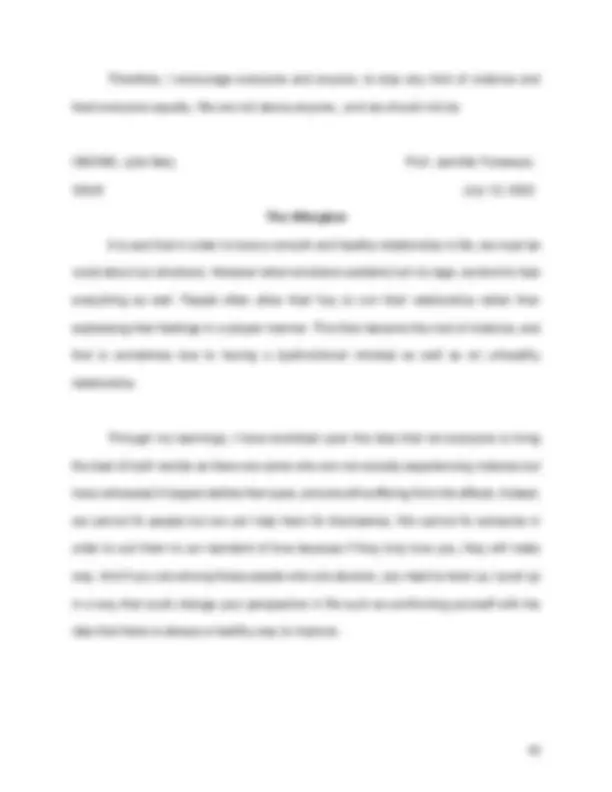
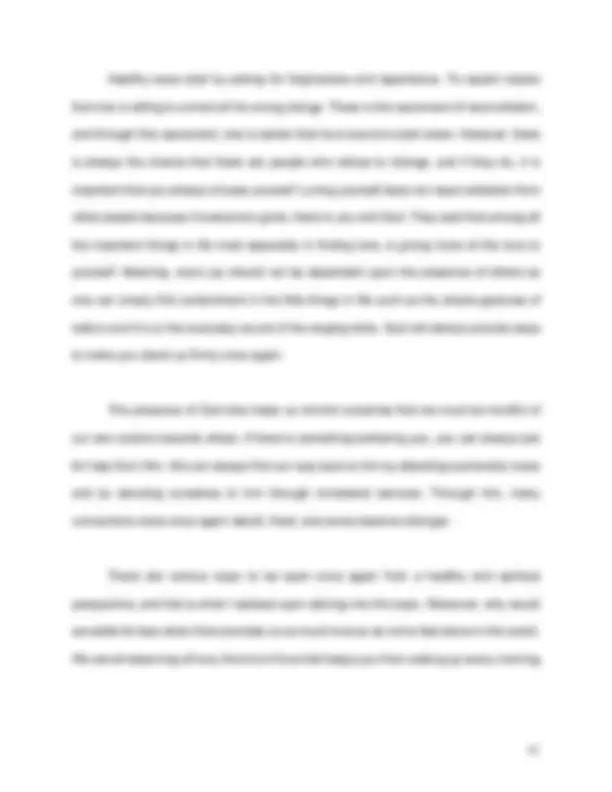
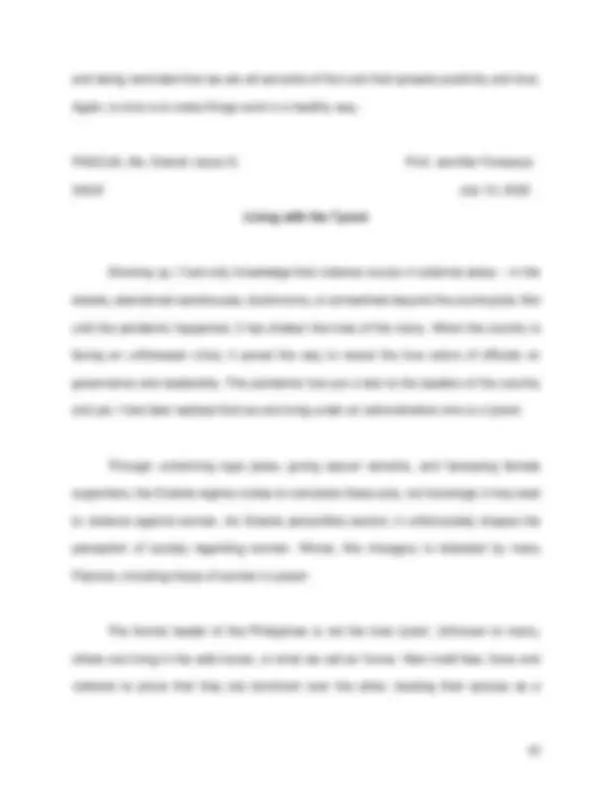
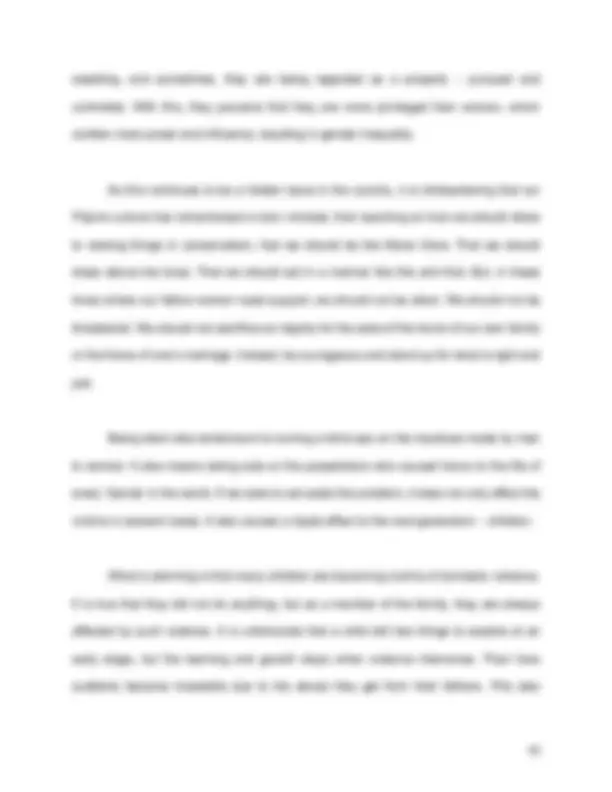
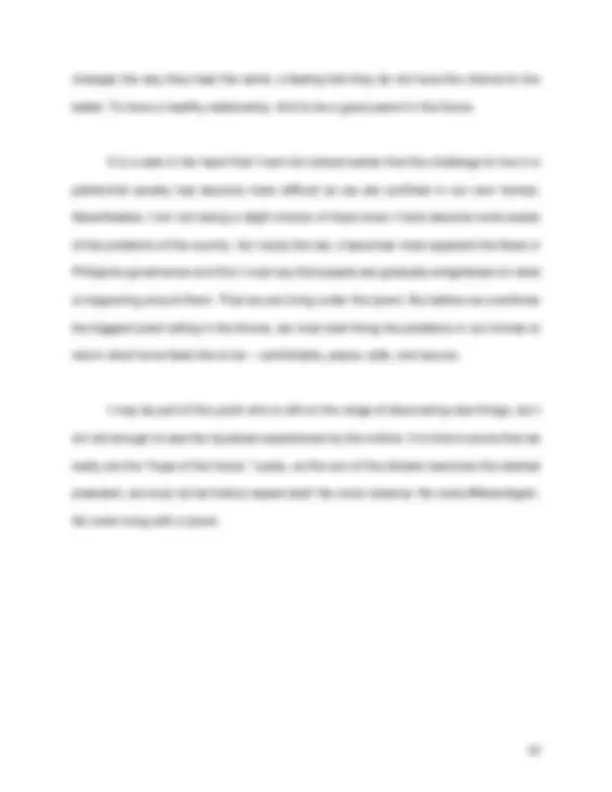
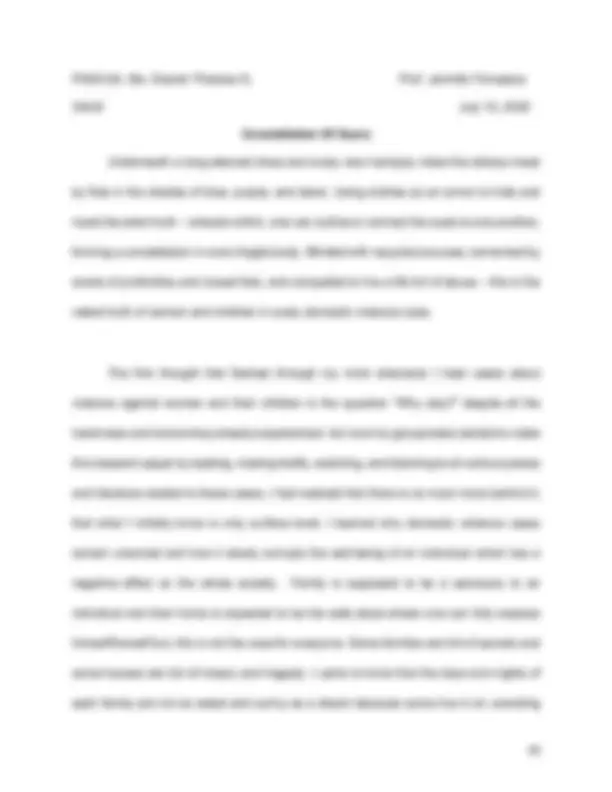
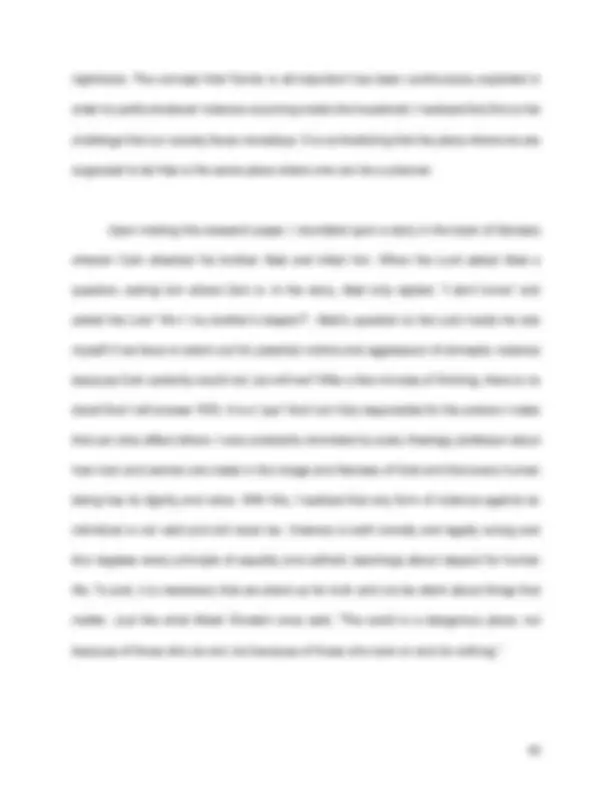
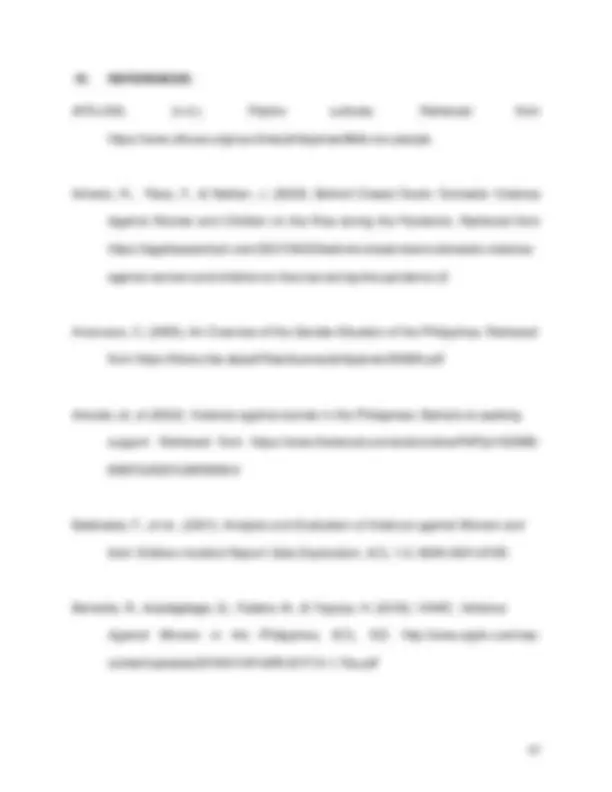
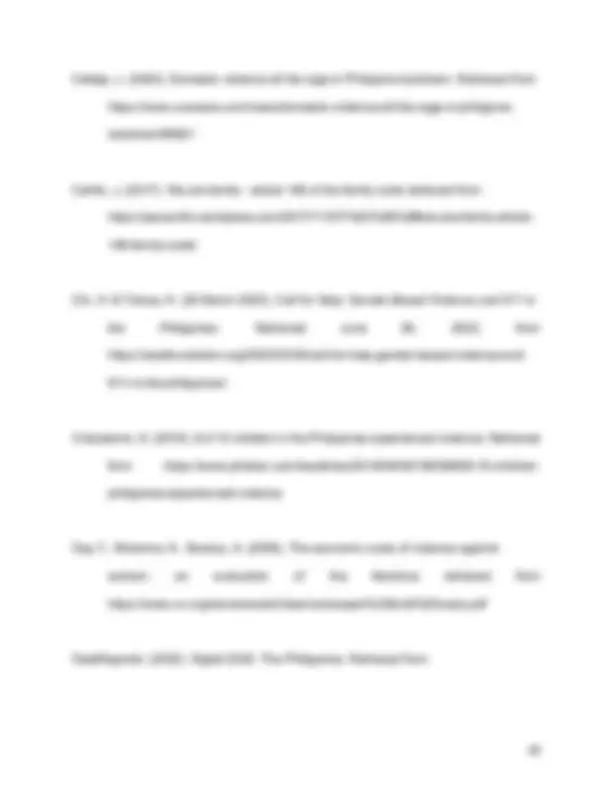
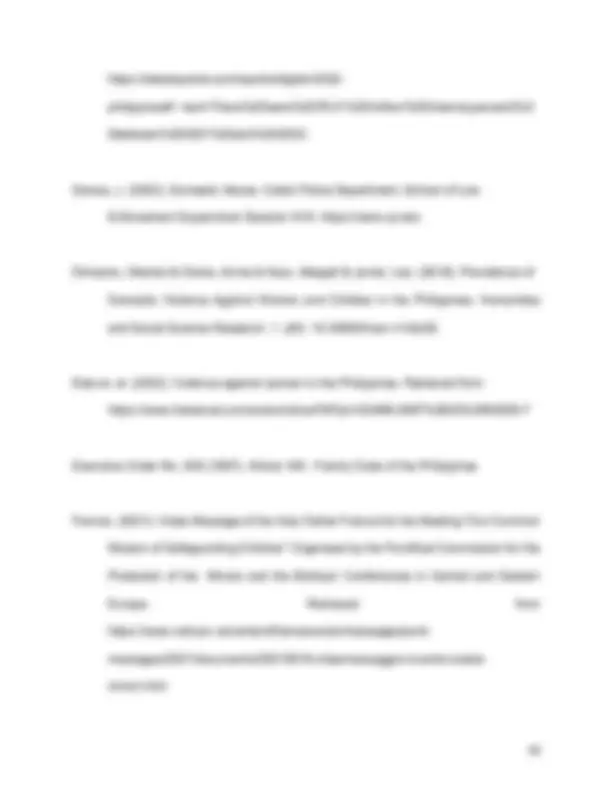
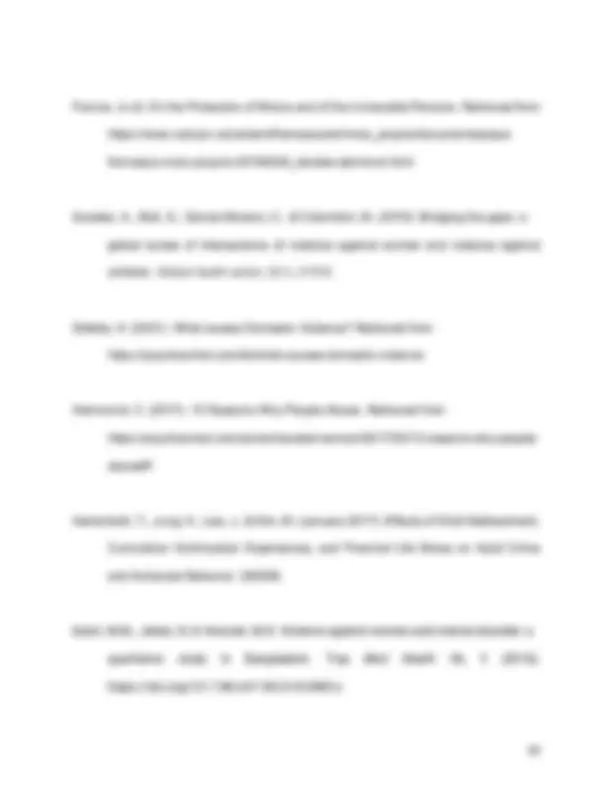
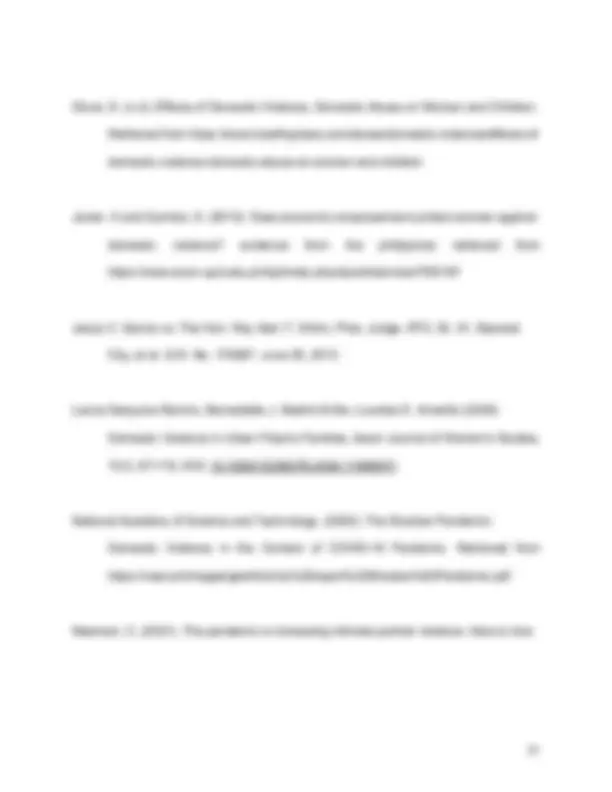
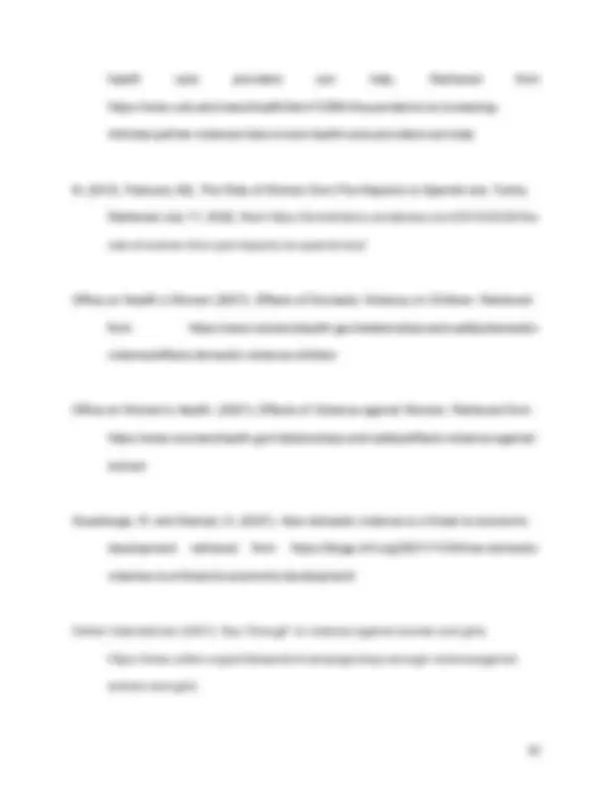
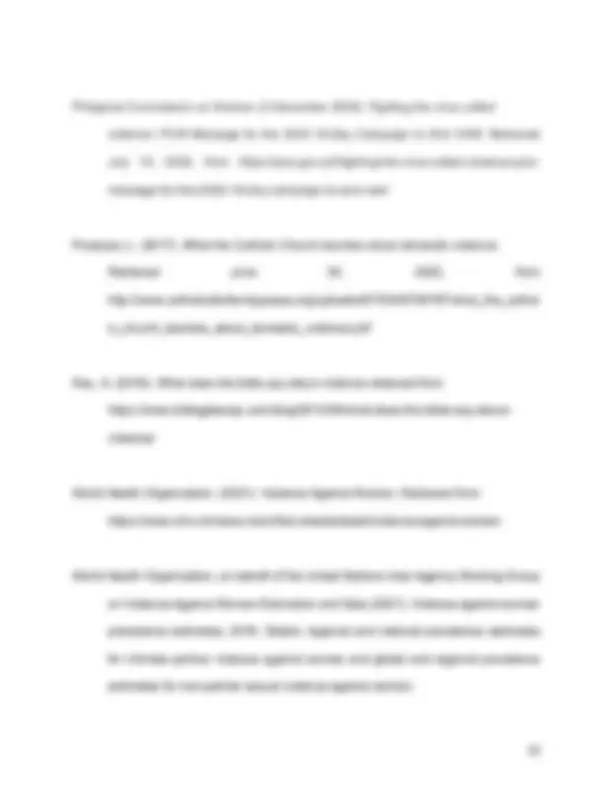
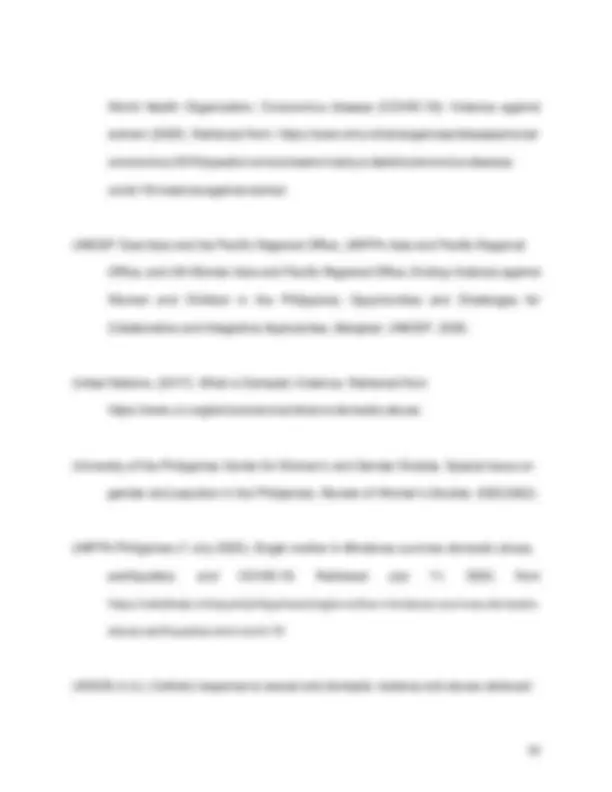
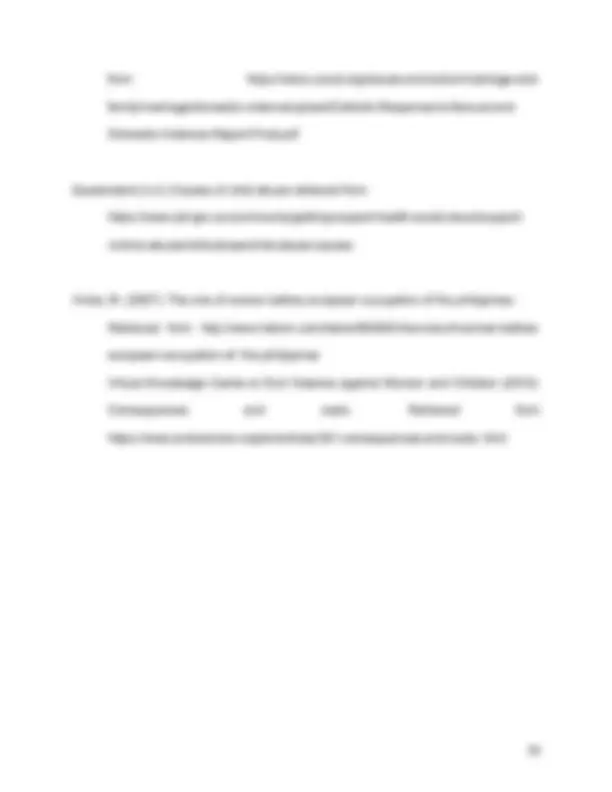


Study with the several resources on Docsity

Earn points by helping other students or get them with a premium plan


Prepare for your exams
Study with the several resources on Docsity

Earn points to download
Earn points by helping other students or get them with a premium plan
Community
Ask the community for help and clear up your study doubts
Discover the best universities in your country according to Docsity users
Free resources
Download our free guides on studying techniques, anxiety management strategies, and thesis advice from Docsity tutors
RESEARCHRESEARCHRESEARCHRESEARCHRESEARCHRESEARCHRESEARCHRESEARCH
Typology: Thesis
1 / 58

This page cannot be seen from the preview
Don't miss anything!



















































College of Arts and Sciences BS Legal Management Manila A.Y. 2021- 2022 THE HOUSE ARREST OF US: EFFECT OF DOMESTIC VIOLENCE ON WOMEN AND THEIR CHILDREN’S WELL-BEING FINALS EXAM In Partial Fulfillment of the Requirements for the subject THED05: Sacraments and Family Life Submitted by: ANCHETA, June Nissa Angela MARTIN, Jan Paolo OBONG, Jylle Naly PASCUA, Ma. Dianah Joyce PASCUA, Ma. Dianah Therese 3ALM Submitted to: Prof. Jennifer Fonseca July 12, 2022
As a form of gratitude, the researchers would like to give recognition to everyone who invested time and effort for the success of their study. Thus, it is rightful that the researchers give acknowledgement to the following: With great recognition, the researchers express their deepest thanks to God, the Father Almighty for his constant guidance throughout the processes in which the researchers have undergone. Thus, it is only correct that the researchers recognize Prof. Jennifer Fonseca, for her constant encouragement throughout the entire research process. As such, the researchers consider her guidance on the study's premise as significant factors of development in the field of research. Lastly, the researchers would like to provide gratitude towards their families, friends, and classmates for their vote of support in the development of the study. This research would not be possible without their consistent prayers from the beginning until the end.
As the adage says, “There is no place like home.” When we hear the word ‘home,’ our minds instinctively transports to a familiar comfort zone, and its relaxing impact that can be felt any time. “Home” has a distinct meaning for us. Some people associate the word with images of the countryside or a cozy bed. What memory we may have of our home, the overarching emotion is that of love, comfort, and a sense of belongingness. However, the imagination of living in homes experiencing terror, emotional torment, or physical injustice leaves an uneasy feeling. Regrettably, this is the stark reality for many women and children in the society, who continue to grapple from domestic violence; the assailant being none other than their own husband. Moreover, fairytales have a huge influence on Filipinos' perception of reality. The elements in folktales and fairytales, may it be local or foreign, include history, spiritual beliefs, and value systems. It made childhood girls believe in the popular quote, ‘happily ever after.’ Through marriage, it is the sole getaway for love and companionship. All fairytales have taught us one thing: marriage is the ultimate conclusion to happiness. However, this narrative is the biggest lie taught to us at a very young age. It pierces the essence of that belief because in reality, the vow that knots the members together oftentimes become a knot to bind people to a cage of abuse and terror – a choking knot. In the case of Garcia vs. Drilon (G.R. No. 179267), Supreme Court noted that the Philippines hailed as the bastion of Christianity in Asia, having 86.8 million Filipinos or
93% of its population adhere to the teachings of Jesus Christ. Justice Perlas-Bernabe however emphasized that “the admonition for husbands to love their wives as their own bodies just as Christ loved the church and gave himself up for her failed to prevent, or even to curb, the pervasiveness of violence against Filipino women.” Violence against women appears as one of the country’s prevalent social problems; it is deemed to be closely related with the unequal power relation between women and men otherwise known as “gender based violence”. Statistics reveal that one in four Filipino women age 15-49 has experienced physical, emotional or sexual violence by their husband or partner. According to the Philippine Commission on Women, concrete information showing the extent of VAW in the country is lacking as many cases of violence against women often go unreported due to women victims’ “culture of silence’; this is also associated with the victims’ lack of faith in the country’s justice system caused by frustrations over the lack of results in filing complaints. Although the fields of violence against children (VAC) and violence against women (VAW) historically developed separately, the international community has paid growing attention to intersections between these forms of violence. The intermingling of love and violence in the form of violence has been a long standing issue not only in the country, but also globally. Such prevailing issue of violence
According to the World Health Organization, one in three women have been subjected to physical and/or sexual intimate partner violence, non-partner sexual violence, or both at least once in their life. Most violence against women is perpetrated by current or former husbands or intimate partners. More than 640 million women aged 15 and older have been subjected to intimate partner violence. This may be a result of several factors such as the trust and affection formed between couples which may have led to over trusting the other and made him control everything, even her freedom. From March 2020 to August 2021, the Philippine National Police (PNP) Women and Children Protection Center received 18,945 VAW cases. Like in any other country, violence against women is a grave violation of women’s human rights, no matter when, where, or how it takes place. There are many forms of violence against women, which have many potential negative health consequences equally for women and their children. The effects of violence are very often long-lived. The most common form of violence against women are verbal abuse, sexual harassment, physical abuse, denial of basic needs and means of communication. According to studies, most women who are victims of domestic abuse or intimate partner violence often go through the “Walker Cycle Theory of Violence,” a tension- reduction theory which explained that there are three distinct phases associated with a recurring battering cycle: (1) tension-building, (2) acute battering incident or violent episode phase, and (3) loving contrition or honeymoon or remorseful phase. According
to Walker, the victims don’t expose their abuser openly because they’re afraid. They’re afraid that things could get worse, especially when they’re financially dependent on their aggressor. With each cycle, the length of time required to complete it becomes shorter and the violence within it increases. (Walker, 1979) In the first phase, there’s a gradual escalation of tension. There are incidents involving jealousy, shouting, or small fights. The victim interprets these insults and verbal abuse as isolated cases that are under control. The aggressor experiences sudden mood swings and they become angry at unimportant things. The next phase is the shortest of the three. Violence erupts in this stage. There’s a lack of control, which is why the physical, psychological, and/or sexual aggression occurs. The victim experiences disbelief and anxiety and they tend to isolate themselves. They may feel powerless in regards to what has happened. They usually wait several days before asking for help. In the last phase, the aggressor usually asks for forgiveness and promises the victim that it’ll never happen again. They use manipulative strategies to make sure that the relationship doesn’t end. This sudden change in attitude makes the victim think that it was a one-time event that will never happen again. The victim wants to believe that the abuser will never do anything like that again. However, as it is called a “cycle”, this violence may restart from the top and may not end if the victim doesn’t opt to do so.
In one of their quarrels, the petitioner grabbed the private respondent on both arms and shook her with such force that caused bruises and hematoma. There was also a time where the petitioner hit Rosalie forcefully on the lips that caused some bleeding. The husband petitioner also turned his ire on their daughter, Jo-Ann, who had seen the text messages he sent to his paramour and whom he blamed for squealing on him. He beat Jo-Ann on the chest and slapped her many times. When the private respondent decided to leave the petitioner, Jo-Ann begged her mother to stay for fear that if the latter leaves, petitioner would beat her up. Even their sons, at a young age, were aware of their mother’s sufferings. Their 6-year-old son even once stated that when he grows up, he would beat up his father because of his cruelty to the private respondent. In denying the husband’s petition for review on certiorari, the Supreme Court reiterated Justice Puno’s observation that ‘the history of the women's movement against domestic violence shows that one of its most difficult struggles was the fight against the violence of law itself. If we keep that in mind, law will not again be a hindrance to the struggle of women for equality but will be its fulfillment.’ Meanwhile in Tulunan, North Cotabato Philippines , rainy days remind a certain “Sarah” (not her real name) of bitter memories. She is a single mother in Mindanao who vividly recollects the pains that she went through because of her partner.
In an article published by the United Nations, ‘Sarah’ narrated how his husband forced her and their children to leave their home. The idea of a failed relationship and uncertainty as to how to raise her little sons by herself alone , distressed Sarah giving her sleepless nights. However, she did not file a complaint against her partner and instead settled for monthly financial assistance (UNFPA Philippines, 2020). The reluctance of the victims to pursue complaints against their partners and the former’s tolerance of abuse are the problems which boil down the culture. In connection to victims’ reluctance to pursue the complaint, problems like costly, lengthy litigation and corruption in the judiciary and prosecution exist. These problems discourage the victims in filing formal complaints. (Dimaano, et al, 2018) When will enough really be enough? How many women shall endure and embrace a life of abuse? How many children must be bruised and broken at the hands of their parent/s? How many bones are needed to be broken? How much blood needs to be spilled? How many tragedies will open our eyes to see that violence will never have a valid justification? Becoming a prisoner in a house of abuse with no safe escape to hide into. Locked in a room full of obscurities, their voices remain unheard nor seen. This has been the life of the victims of domestic violence – a life of misery and insignificance.
A. Economical Aspect “The economic costs of domestic violence are higher during downturns and could make recovery more challenging,” said by Ouedraogo and Stenzel, economists of the International Monetary Fund. Even if domestic violence against women and children occurs in the confine of homes, greatly affecting the individuals living in that household, it also has an impact to the society’s entire economy wherein it hinders to fully achieve progressive growth and impedes economic development. (Day, McKenna, Bowlus, 2005). The New IMF staff research shows that violence against women and children is considered as a major threat to economic development in regions where domestic violence is widespread. Such violence is said to be a drain on society wherein it has a multi-dimensional effect on the overall health of the society’s economy both in short and long-term. For the short term effects, it shows that women from abusive homes tend to work fewer hours and are likely to be less productive in their work. As for the long-term effects, domestic violence causes the decrease in the number of women in the workforce. It will also minimize the acquisition of skills and education of women and children. In the long-run it will negatively affect the nation’s economy wherein Gross Domestic Product (GDP) will drop due to significant decline in female employment.
IMF’s research found that there is a negative impact of domestic violence on the economic activity of a nation because it is more detrimental to countries that do not have enough protective laws against domestic violence (Ouedraogo and Stenzel, 2021). According to a Bernarte et al. (2018), one common factor of violence against women is the economic aspect wherein it involves the financial facet of women including her family’s economic background and the ability to give financial support to the head of the family. One of the factors that caused violence against women is unemployment as reported by the Chief of Women and Children Protection Services of the Manila Police District. Women who are positioned in the lower income bracket are most likely to become the victim and are vulnerable to violence. Economic perspectives of domestic violence supports the notion that the violence women experience depends on their income and that the higher incomes of women tend to reduce the violence one will experience. However, there are still victims of such abuse coming from well-off families but remained silent due to the fear of staining the family’s reputation. Violence does not choose its victims since it cuts across all sectors of the society, making all women vulnerable to such abuse, whether they be rich or not (Philippine Commission on Women, n.d.). B. Legal/Political Aspect Aysha Taryam, the first Middle-Eastern female Editor-in-Chief of an english language newspaper once emphasized, “If we are to fight discrimination and
— In this light, our government has long recognized the importance of protecting women and their children against violence and threats to their safety and security. Considering the aforementioned, several government agencies and programs have been established to perform functions that serve such a purpose; the Philippine Commission on Women (PCW), which was created in 1975; the Women and Children Protection Center (WCPC) of the Philippine National Police (PNP); and the Gender and Development (GAD) Program in all government departments. The government has also tied up with the United Nations (UN) agencies and civil society organizations in pursuing its goals of ending VAWC and helping people who suffered from gender-based violence — it is crucial to highlight, however, that the biggest step that the government has taken to date, was the passage of Republic Act 9262, or the Anti-Violence against Women and their Children Act of 2004. Republic Act No. 9262 or the Anti-Violence against Women and their Children Act of 2004 is the primary law that seeks to address the prevalence of violence against women and their children (VAWC) by their intimate partners such as their husband or ex-husband, live-in partner or former live-in partner, boyfriend/girlfriend or ex-boyfriend/ex-girlfriend, dating partner or former dating partner (Philippine Commission on Women). The law substantially enumerated the several acts which may constitute violence, as well as its classifications including, but not limited to, physical and psychological abuse. It further provides for the
different penalties which may be imposed in violation thereto, in hopes to curb the effects of VAWC and fortify the rights of our women and children. Despite the combined efforts from the government and non-governmental organizations (NGOs), however, VAWC remains rampant. In a study conducted by Balahadia et. al, (2021) , it was stated that among women aged 15 to 49, one out of four reported having suffered physical or sexual violence in the 12 months preceding the National Demographic and Health Survey (NDHS) in 2017. Data from the Philippine National Police (PNP) also revealed that physical abuse accounted for 38.54 percent of the 108,675 cases of domestic violence, making it the most common. Furthermore, in a a survey commissioned by the Commission on Population and Development (POPCOM) in early 2021 and conducted by the Social Weather Stations (SWS), it was also reported that “harmful acts” in the form of physical, sexual, and emotional violence are causing great concern in their everyday life under the “new normal” for 25% of the adults surveyed. Twice as important is our state’s role in protecting our children. Deemed included in our laws against the threat of VAWC, all children in the Philippines, and Filipino children elsewhere, are protected from all forms of violence, abuse, exploitation and discrimination. As the unfathomable COVID-19 pandemic struck the world, however, children’s vulnerability to violence and exploitation was exacerbated.
is toxic and abusive. A repressive culture insists that whatever happens in a marriage is a private affair between the married couple, even if it becomes violent or criminal in nature. It is a culture that accepts abuse of children and believes that parents have the right to impose discipline. Moreover, this culture creates an unhealthy environment wherein it tolerates violence against women and children and merely regarded it as a form of showing authority in the household. With this, it has created a culture of silence among the members of the family and this problem remains a hidden and unresolved issue in society as domestic violence occurs in the confines of homes (Philippine Human Development, 2012). In addition, Philippine Human Development (2012) asserts that violence against women persists because of the cultural beliefs and traditions that conditioned the people to perceive that a man and a woman have different roles in the society. For Anonuevo (2000), the extensive history of colonialism in the Philippines has become the byproduct of patriarchal culture among Filipinos. He states that men are expected to take dominant roles like being a leader, pursuer or a provider while women are expected to only take subordinate roles like being a supporter, be a men’s companion or be a nurturer. Women are regarded as full- time homemakers and beneath men. In relation to that, Arevalo, et. al (2022) states that women's pleasures are seen as vulnerable since they are seen as objects to pursue or control. This perception creates inequality among men and women wherein men have more social privileges than women; hence, giving more power and control to men than women.
Due to high expectations of the society, women tend to sacrifice safety and security in favor of family reputation. Consequently, there is also a culture of victim- blaming from the fact that defying gender norms incentivizes objectification, humiliation, guilt, and even justification of violence. Through demeaning women, tolerating rape jokes and sexual remarks, publicly harassing female journalists and/or reporters, linking femininity with frailty, and inciting the military to shoot women ‘communist rebels’ in the vagina,” the Duterte regime epitomizes sexism and shapes the view of society to women. People who are recognized as “ Feminists of Convenience,” support women’s rights, but tend to keep quiet about Duterte’s actions out of consideration for their own families and careers as well as to prevent political backlash. Through their silence, the culture of impunity continues to exist (University of the Philippines Center for Women’s and Gender Studies, 2020 as cited in Arevalo et. al, 2022). The effects of domestic violence are likely the same with the preservation of Filipino culture – long-lasting. According to the Office on Women’s Health (2021), there are various effects and consequences of violence, having immediate and short-term to inter-generational effects, however, the consequences and costs of violence have impacts at the individual level, as well as within the family, community and wider society, which translate into costs at the national level. The short-term effects include slight injuries or severe conditions. Injuries to internal organs, as well as cuts, bruises, broken bones, are also included. Also, sexual or